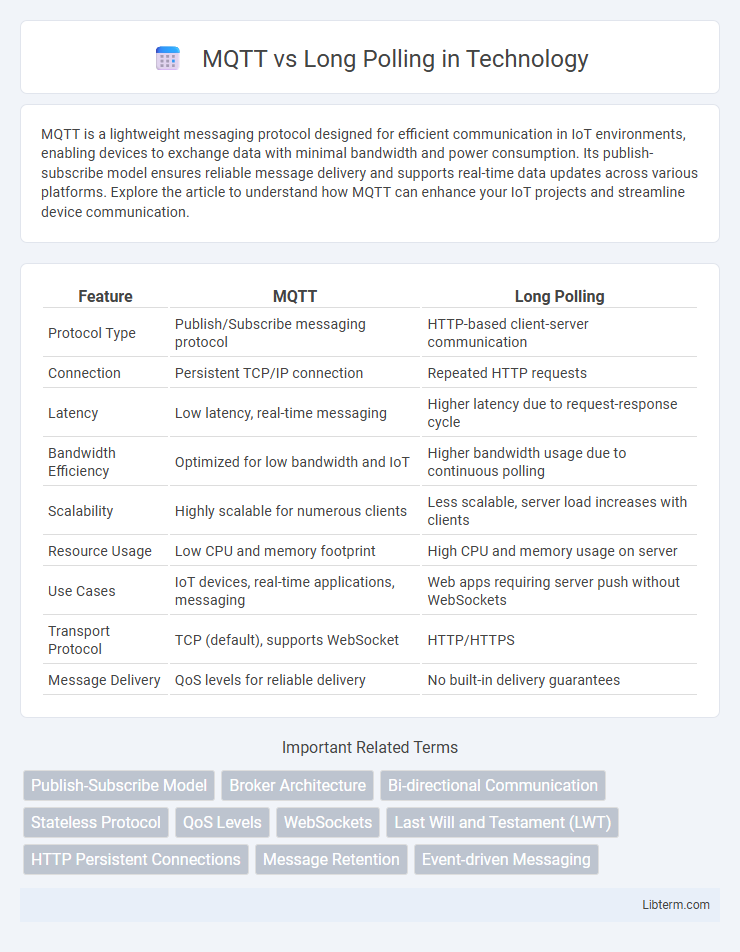MQTT is a lightweight messaging protocol designed for efficient communication in IoT environments, enabling devices to exchange data with minimal bandwidth and power consumption. Its publish-subscribe model ensures reliable message delivery and supports real-time data updates across various platforms. Explore the article to understand how MQTT can enhance your IoT projects and streamline device communication.
Table of Comparison
| Feature | MQTT | Long Polling |
|---|---|---|
| Protocol Type | Publish/Subscribe messaging protocol | HTTP-based client-server communication |
| Connection | Persistent TCP/IP connection | Repeated HTTP requests |
| Latency | Low latency, real-time messaging | Higher latency due to request-response cycle |
| Bandwidth Efficiency | Optimized for low bandwidth and IoT | Higher bandwidth usage due to continuous polling |
| Scalability | Highly scalable for numerous clients | Less scalable, server load increases with clients |
| Resource Usage | Low CPU and memory footprint | High CPU and memory usage on server |
| Use Cases | IoT devices, real-time applications, messaging | Web apps requiring server push without WebSockets |
| Transport Protocol | TCP (default), supports WebSocket | HTTP/HTTPS |
| Message Delivery | QoS levels for reliable delivery | No built-in delivery guarantees |
Introduction to MQTT and Long Polling
MQTT (Message Queuing Telemetry Transport) is a lightweight, publish-subscribe network protocol designed for constrained devices and low-bandwidth, high-latency, or unreliable networks. Long Polling is a web communication technique where the client requests information from the server and holds the connection open until new data is available, simulating real-time data transfer over HTTP. Both methods are used to enable real-time updates, but MQTT is optimized for IoT devices with minimal overhead, while Long Polling relies on traditional HTTP protocols with higher latency and resource consumption.
Core Principles and Architecture
MQTT operates on a lightweight publish-subscribe protocol optimized for low-bandwidth, high-latency networks, using a broker to manage message distribution efficiently. Long Polling relies on HTTP requests where the client sends a request to the server and waits for a response, maintaining an open connection to simulate real-time communication. MQTT's event-driven architecture enables asynchronous message delivery, while Long Polling mimics server push functionality over stateless HTTP, resulting in higher latency and overhead.
Communication Protocols Overview
MQTT is a lightweight, publish-subscribe communication protocol designed for efficient, real-time data transfer in IoT and constrained networks, using a broker to manage message distribution. Long Polling operates over HTTP, where clients make requests and hold them open until the server sends data, simulating full-duplex communication but with higher latency and overhead. MQTT's event-driven model ensures lower bandwidth usage and faster response times compared to Long Polling's traditional request-response mechanism, making it ideal for scalable, low-power device communication.
Performance and Scalability
MQTT offers superior performance over Long Polling by maintaining persistent connections that reduce latency and minimize overhead, making it ideal for real-time IoT applications. Scalability is enhanced in MQTT through efficient message distribution using a lightweight publish-subscribe model, which supports millions of simultaneous clients without excessive server strain. In contrast, Long Polling relies on repetitive HTTP requests, increasing server load and latency, limiting its effectiveness in large-scale, high-throughput environments.
Latency and Real-Time Capabilities
MQTT provides significantly lower latency compared to Long Polling by maintaining a persistent connection that enables instant message delivery, making it ideal for real-time IoT applications. Long Polling introduces higher latency due to its repeated HTTP request-response cycles, which delay data transmission and reduce efficiency. MQTT's publish-subscribe architecture supports scalable, real-time communication with minimal network overhead, outperforming Long Polling in dynamic environments requiring immediate data updates.
Resource Consumption and Efficiency
MQTT uses a lightweight publish-subscribe protocol that minimizes network bandwidth and CPU usage, making it highly efficient for low-resource environments like IoT devices. Long Polling repeatedly makes HTTP requests, increasing CPU load and network overhead due to constant connection setups and tear-downs. MQTT's persistent TCP connection and optimized message delivery significantly reduce resource consumption compared to the continuous polling cycles of long polling.
Security Features Comparison
MQTT employs TLS encryption and supports mutual authentication, ensuring secure and lightweight messaging for IoT applications, whereas Long Polling relies heavily on HTTPS for data transport security, which can be less efficient in maintaining persistent connections. MQTT's protocol design minimizes attack surfaces by using a broker for message handling, reducing direct client exposure, while Long Polling's repeated HTTP requests may increase vulnerability to interception and replay attacks. Both protocols benefit from standard security practices, but MQTT's native support for secure communication and authentication provides a more robust security posture for real-time, resource-constrained environments.
Use Cases and Industry Applications
MQTT excels in IoT and real-time messaging use cases where low latency and efficient bandwidth are crucial, such as smart home systems, industrial automation, and connected vehicles. Long Polling is more suitable for web applications requiring server push capabilities without persistent connections, like live chat, notifications, and dynamic content updates. Industries leveraging MQTT include manufacturing, agriculture, and healthcare, while Long Polling remains common in web development and customer service platforms.
Implementation Complexity
MQTT offers lower implementation complexity for real-time communication due to its lightweight publish-subscribe protocol designed for efficient message delivery over unreliable networks. Long Polling requires more intricate server-side handling and resource management, as it simulates real-time data transfer by holding HTTP requests open until new data is available. Developers often find MQTT simpler to integrate in IoT and mobile applications because it minimizes overhead and supports persistent connections.
Choosing the Right Approach
Selecting MQTT over Long Polling enables efficient, low-latency communication ideal for IoT and real-time applications due to its lightweight publish-subscribe model and persistent connection. Long Polling suits scenarios requiring simpler implementation without continuous socket connections, but it incurs higher overhead and latency from repeated HTTP requests. Choosing the right approach hinges on factors like network reliability, message frequency, device constraints, and scalability needs.
MQTT Infographic

 libterm.com
libterm.com